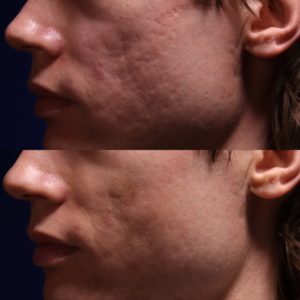Are Acne Scars Forever?
Scarring is an unfortunate consequence of uncontrolled acne. A frequently cited 1994 study reported that up to 95% of respondents experience some extent of scarring from acne. While the severity does range drastically from individual to individual, there is no doubt that acne can pose significant cosmetic concerns especially to adolescents and young adults.
What is worse is that acne scars are indeed permanent. The good news is that acne scars are highly treatable. After treatment, some individuals can barely tell that they even had acne scars in the first place.
In this article, we will discuss the different types of acne and acne scarring, treatment options, and preventative measures you can take to maintain clear skin.
What types of acne are there?
Acne comes in all varieties:
- Papular acne: Small, red bumps with mild inflammation
- Pustular acne: Similar to papular acne except with a white pus-filled center (hence the name “pustular”).
- Comedonal acne: Can either be “opened” or “closed.” Open comedones are non-inflamed clogged oil plugs that are exposed at the skin surface. They carry a characteristic dark hue, which is why they are called “blackheads.” Closed comedones are similar except they have an overlying layer of skin protecting the oil plugs. They are called “whiteheads” due to their light or flesh-colored appearance.
- Nodular/cystic acne: A severe form of inflammatory acne that causes large, painful lumps deep in the skin.
What types of acne leaves scars?
The more severe the acne, the more likely it is to scar. Nodular or cystic acne is the most severe type of acne due to its extensive inflammation deep inside the dermis. Intense, prolonged inflammation is responsible for tissue damage and resulting scar formation. Severe papulopustular acne can also leave behind scars.
Whiteheads and blackheads are unlikely to scar your skin, because they are non-inflammatory subtypes of acne scarring. However, these recurrent non-inflammatory acne can still enlarge your pores and give the appearance of acne scarring. You may want to consider using skincare products that reduce pore size, such as retinol, to prevent whiteheads and blackheads from recurring in the same areas and causing pore dilation.

How can I prevent acne scars?
There are a variety of ways that you can help prevent acne scars. Much of it comes down to your skincare habits.
For instance, skin picking can make your acne scar more easily. Skin picking can prolong inflammation in the skin and thus cause more skin damage. While draining the acne is standard practice, this should be done by a licensed dermatologist or aesthetician to ensure that your acne heals normally.
Lack of skin hygiene is also a contributing factor to acne scarring. Overwashing your face (yes, you read it right!) can promote more acne and ultimately more scarring. You might find this surprising, but the fact is that over-exfoliating or washing your face strips your skin of natural antibacterial properties that help you fight acne. This does not mean that you have to throw away all your face soap. The key is to use face washes and exfoliating products in moderation.
Lastly, there are medical interventions you can explore to lower your chance of scarring. Cortisone shots or, in more severe cases, accutane can help reduce inflammation. Catching the acne early in its course is also important to prevent tissue damage.
How can I get rid of my acne scars?
Like we said earlier, acne scars do not ever completely go away. Scars will always remain in some shape or form once you get them. However, there are so many treatments that you can explore to significantly reduce their appearance.
For flat and/or discolored scars, there are several simple treatments that can produce noticeable results:
- Superficial chemical peels: Alpha- and beta-hydroxy acid peels, including glycolic acid, salicylic acid, lactic acid – and the list goes on, are great options for treating mild discoloration and stimulating collagen production. These agents accelerate turnover of the top layer of skin carrying pigment molecules, called melanin, to fade post-inflammatory pigmentation (PIH). Additionally, these peels have something called “sebostatic” properties. In other words, they hinder oil production, thereby preventing future acne from breaking out.
- Microneedling: Microneedling is a popular at-home and in-office treatment for flat, discolored acne scars. In fact, they can enhance the skin’s absorption of superficial chemical peels by punching microscopic channels into the skin for the chemical agents to enter.
- Laser therapy: Lasers are highly effective for treating minor acne scars. However, one must tread with caution with this treatment, as there is a vast variety of different lasers suited for a variety of different purposes. For PIH, non-ablative lasers (lasers that leave the top layer of skin untouched), such as Nd:YAG, intense pulsed light (IPL), pulsed dye laser (PDL), and ruby laser, are effective. Fractional ablative lasers can also provide the same benefits while also improving skin texture. However, these lasers are not well-suited for deep acne scarring, which we will discuss below.
For moderate to severe acne scarring, “superficial” modalities simply will not do much to get you the results that you would like. Below are some treatment options that target deeper layers of the skin. Bear in mind that these are for depressed acne scars.
- Deep chemical peels: Unlike superficial peels, deep chemical agents such as trichloroacetic acid (TCA) or phenol penetrate the deep dermis. Thus, they are well-suited for deep acne scars, particularly ice pick scars. CROSS is a popular technique for applying these chemical peels, a process in which a fine instrument is used to apply the agent to the scar tissue itself while sparing the surrounding healthy skin.
- Subcision: Subcision is becoming increasingly more popular as a simple manual approach to treating acne scars. This treatment is performed by inserting a needle through the skin to manually break up the scar tissue from underneath. It is a versatile procedure; the surgeon can use a variety of different needles and cannulas and control the depth of the instrument to target the different layers of the skin that the scars inhabit.
- Fillers: There are a variety of fillers that can fill depressed acne scars. To name a few, hyaluronic acid (HA), polymethylacrylate (PMMA), calcium hydroxylapatite (CaHA), and poly-l-lactic acid (PLLA) are different types of fillers with varying durations of efficacy for restoring volume loss resulting from acne scarring. Filler injections are frequently combined with procedures, such as subcision, to enhance results. Aside from treating scars, fillers provide a lot of anti-aging benefits as well.
- Punch excision: This is a last resort procedure when everything else fails. Deep ice pick or boxcar scars may respond poorly to the treatment options above, at which point complete surgical excision is needed. Punch excisions are simple and quick to perform: the scar is removed entirely with a cookie cutter instrument, and the small wound is closed with a stitch. Punch excisions are frequently paired with resurfacing treatments, such as lasers or dermabrasion, to smoothen out the healed stitch site.
- Dermabrasion: Many would say that this is the non-energy-based counterpart to ablative laser treatment. Dermabrasion essentially uses sandpaper or a wire brush to manually scour the skin. Like punch excision, this procedure is typically performed as the last step to “buff” the skin – almost like the finishing step in cleaning a car’s exterior.
There is no universal formulaic solution to treating acne scars. In fact, you might find yourself experimenting with your doctor to see what treatment works best for you.
As a rule of them, the deeper your scars, the more you want to focus on “scar-lifting” techniques, procedures such as those listed above for moderate to severe acne scarring. For flatter scars, only topical treatments tend to be necessary.
Conclusion
Acne scarring is a complex condition that poses a cosmetic concern to millions of people worldwide. In fact, it is so common that it could practically be considered a rite of passage into adulthood after your active acne subsides. However, there are numerous ways you can prevent acne scars from forming, including not picking your skin, creating a conservative skincare regimen, and consulting a dermatologist on necessary medications and treatments.
For those who already struggle with acne scarring, there are a variety of manual-, chemical-, and energy-based treatments that can improve the texture and discoloration of your skin.
Do not lose hope, because there are endless possibilities to achieve smoother and healthier skin. Contact us at Scar Healing Institute and we can help you find a better way to solve your skin issues.
Schedule an Appointment
Scar Healing Institute
Scar Healing Institute is committed to developing the most effective treatments for scarring. Our team of scar revision specialists are continually inventing the latest technologies and formulas to deliver the best results for our patients.

